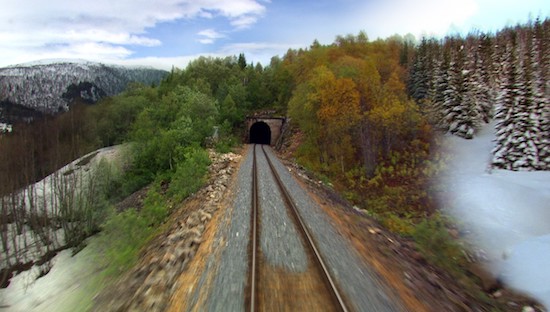What have you missed out on? Blind spots, lacunae, field defects in your cultural attentiveness. We all have ‘em. Even giants can’t see everything – more of whom later.
With such gaps in mind I’m particularly indebted to Kevin Breathnach and his title essay here for directing me to some hypnotically lengthy videos of Norwegian train journeys taken from the driver’s POV. Some might think these powerfully narcotic but, as the author skilfully records, many minor ordinary details grab our attention and snag in the mind; each insistently carries us along for the ride. Breathnach jazzily splices his descriptions of this potentially boring virtual journey with some unreliable memories of his experiments with mephedrone and sex.
His musings on the banal in turn reference Chris Marker’s meditative Sans Soleil (1983) and at moments he even co-opts the French director’s narrative trope that addresses an unknown ‘you’. Breathnach is fond of cinematic kinks (in both senses of the word) as applied to fiction. There’s a story about fucking holes in the ground as a teenager that is strongly reminiscent of a scene in Bertolucci’s 1900 (1976).
The discontinuous essays here, in his own words on Sans Soleil and that Norwegian train ride, have a “shared disavowal of storyline”. He notes that the opening intertitles of Dziga Vertov’s Man with a Movie Camera (1929) inform us that the film “aims at creating a truly international language of cinema based on its absolute separation from the language of theatre and literature”. But conversely Breathnach’s texts imply that these days a writer is hard pressed to construct a narrative utterly indifferent to cinematic innovation.
Tunnel Vision is a pungent bouillabaisse of high culture. Breathnach does not wear his learning lightly; he wants us to know he’s pretentious in the more positive understanding of the term. As he says with a nice hint of self-mockery that his “sense of identity and self-worth has for years been grounded in the conspicuous and frequently unfelt enjoyment of high culture”. He hints at his overabundance of signifiers, what Nabokov would call his referential mania, with one of the final stories in his book.
A Spanish man in an airport is seen carrying two large Burger King bags bulging with food. Stuff begins to fall out – “the tunnel was a horrifying ruin of beef patties, Coca-Cola, popcorn chicken, the lot.” In similar fashion Breathnach spills his influences like a scatter artist. Indeed Tunnel Vision can be viewed as a nostalgic read for those of the post-punk generation with its extensive roll call of cultural titans given a name check. Like the old NME column from the early 80s, ‘Portrait of the Artist as a Consumer’, there is a cornucopia of nods and winks to past greats: Sontag, Godard, Thomas Bernhard, John Berger, Kafka, Thomas Mann, Genet, Patrick Modiano, Renata Adler, the Goncourt brothers… the list goes on. As for photography Breathnach’s explications can be counted as acute as those of Geoff Dyer with his writings here on André Kertész, Stephen Shore, and Bernice Abbot.
There is serious ambition at work in Tunnel Vision. I’m reminded of the fragmentary approach of Breathnach’s compatriot Aidan Higgins; they share a similar flitting of geographies. Breathnach colours his reports as they skit from Madrid to Paris, from Chemnitz to Munich and from South Korea to his hometown of Dublin.
His concerns are not all highfalutin and he touches on more popular interests. Football isn’t ignored. There’s a troublingly touching tribute to his great uncle (is this true?) Liam Whelan, the terrific Manchester United goal scorer tragically killed in the Munich disaster. And it’s startlingly outré to see Steve Bruce getting a mention alongside the wall of Mitteleuropean literary genius.
All very interesting. The blurb from Sally Rooney on the back cover of Tunnel Vision describes Breathnach as “one of the most interesting writers working in Ireland today”. Is that hedging a bet? And what do we mean by ‘interesting’?
There’s been much comment about the use of the word in the title of the current Venice Biennale, May You Live in Interesting Times, and in particular about the nuances of that seemingly neutral word ‘interesting’. Something might be good or bad and still be interesting. To be clear: Tunnel Vision is mostly very good, although some things might cause a moment of mephedrone-like teeth grinding, a bit of bruxism – as when we see Ian Buruma’s name misspelt twice.
Amidst all the chiming and rhyming is there one take-home message in Tunnel Vision? That would be unfairly reductive but there’s the persistent suggestion that even the best artists, the wisest philosophers, can be brought down to size. A literary critic at the Irish Times takes a bashing. And Man Ray takes a hit, being described as a “domestic abusive wannabe-painter”.
The medical term for tunnel vision is a bitemporal hemianopia. The giant Goliath is said to have had such as a result of a pituitary tumour making excess growth hormone. And so despite his strength he was cut down by little David blind-siding him. Breathnach looks up to his gloomy heroes with a sling in one hand. The snapshot approach of his musings implies that we are forever moving, as he notes, “backward into darkness”. As Samuel Beckett once said to Aidan Higgins: despair young and never look back.
Tunnel Vision by Kevin Breathnach is published by Faber


